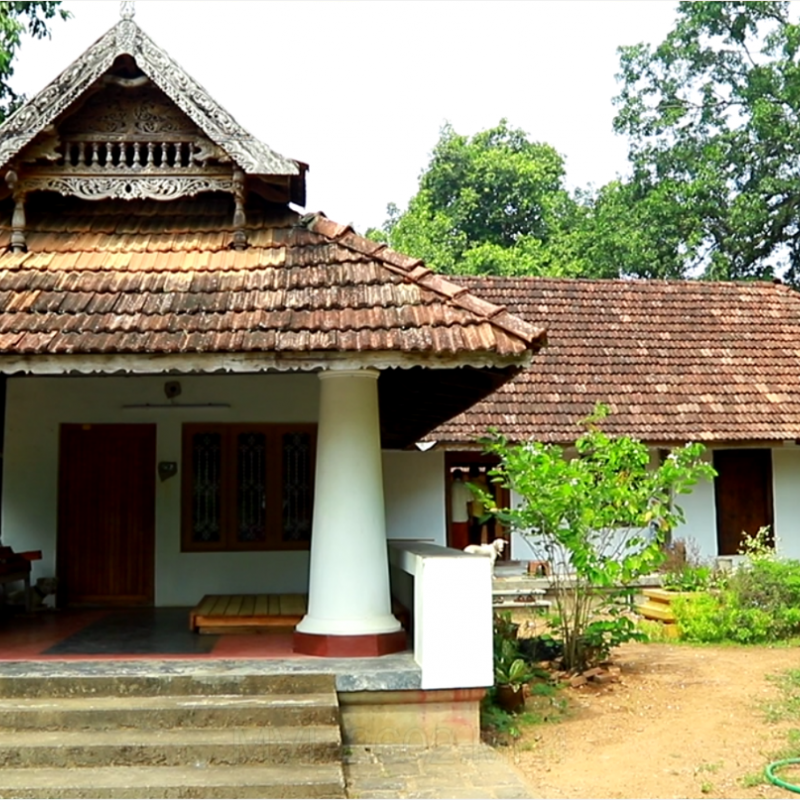The Kingdom of Cochin, originally known as Perumpadappu Swarūpam, was a part of the extensive Late Chera Empire of the medieval period, which extended over large parts of South India including modern-day Kerala, with Thiruvanjikulam (near present-day Kodungallur in Thrissur district) as its capital.[1] This medieval Hindu kingdom is said to have covered a large territory between Ponnani (in present-day Malappuram district) and Thottappally (Alappuzha district). A. Sreedhara Menon in his Survey of Kerala History remarks that the Namboothiri chief of Perumpadappu—not the present-day town in Ernakulam district, but a place in Ponnani Taluk in Malappuram district—had entered into a marital alliance with the sister of the then Chera king, Rama Varma Kulasekhara, and in return gained certain religious, ritualistic and cultural rights including the control of the Thirunavaya temple and rights to conduct Mamankam.[2]
This article discusses the history of this kingdom in two phases; the first pertains to the early history till 1498, before the European arrival in Malabar, and the second, the period after the entry of the Europeans—including the Portuguese, the Dutch and the British—until the middle of the twentieth century.
Most of the ancient and medieval sources are either copper plates that narrate certain orders or sanctions by various rulers and records like Granthavari. Swarūpam was one of the major political units of pre-modern Kerala. The meaning of the term ‘Swarūpam’ is self-form. They were large joint families and their political authority was organised on the basis of kuru (seniority). After the decline of the Chera empire, there were four major Swarūpams in Kerala—Kolaswarūpam (Kannur), the Nediyirippu Swarūpam (Kozhikode), the Perumpadappu Swarūpam (Kochi), and the Venadu Swarūpam (Travancore).[3] Swarūpams were ruling houses that controlled the regional territories or Nadus. Most of the prevalent history of the kingdom is based on mythical sources and tales from a few manuscripts like Keralolpathi, Keralamahatmyam and Perumpadappu Granthavari.[4]
Most of these sources concur on the existence of a lineage of designated kings in the region with the title ‘Perumal’ whose tenure lasted for 12 years. The ancient text of Keralolpathi has a narrative about the last Perumal, Cheraman Perumal, who left for Mecca on hajj and converted to Islam. Before leaving, he divided the kingdom between his nephews and sons according to the legend. Most historians believe that Cheraman Perumal’s rule (Second Chera Dynasty 825–1102) ended around 1102 CE and it is widely agreed that he belonged to Cholamandalam in Tamil Nadu. In Keralolpathi, it is mentioned that the division of the kingdom took place in 345 CE. Whereas in Perumpadappu Granthavari this is marked as to have occurred in 385 CE and, according to the classic text by William Logan, the event took place in 355 CE.[5] Different sources indicate differing details of this and according to the modern historian Elamkulam Kunjan Pillai, the division might have occurred during the Second Chera Kingdom at the beginning of the twelfth century.
The Perumal’s seat was said to be at Thiruvanjikulam (near Kodungallur). The whereabouts of the royal residences is not known. Thiruvanjikulathappan (lord of Thiruvanjikulam) is considered as one of the Paradevathas (family deity) of the royal family as it was customary for the family to adopt the local deity of the particular village of residence as their Paradevatha. The shrine at Thiruvanchikulam was supposed to be renovated during this Perumal’s time. Even today this temple has a small consecrated idol dedicated to Cheraman Perumal.
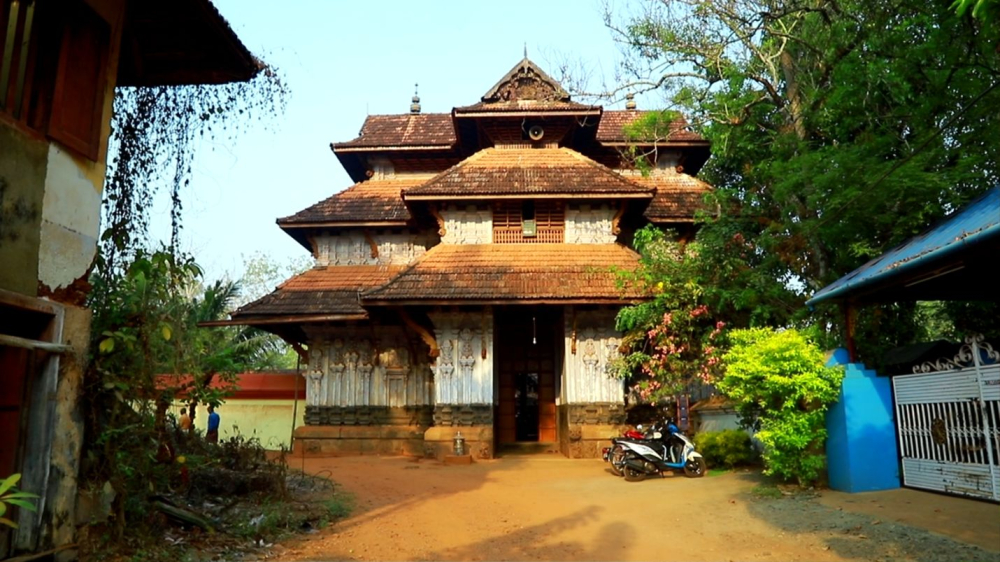
A popularly circulated story says that Cheraman Perumal’s sister was married to a Namboothiri of the Perumpadappu Illam (family) and, during the partition of the empire, Perumal’s nephew (son of this Namboothiri) got a stretch of land where he later established the Perumpadappu Swarūpam. The nephew of Cheraman Perumal was called Veera Kerala Varma. The myth goes on to say that Veera Kerala Varma was anointed as Chakravarthy (supreme ruler) on the day of Atham in the month of Chingam (in the Malayalam calendar, Kollavarsham) as he was considered the noblest of all rulers of the time. The day and month of this anointment coincides with the festival of Onam and in present times a procession called Atha-Chamayam takes place in Thrippunithura that commemorates this event. In this procession the contemporary king, ordained with a star and his sword, walks through the streets of Thrippunithura in a procession followed by his retinue and attendants.
The ancestral house of Perumpadappu Namboothiri is situated at Vanneri in Malappuram district. The only remnant of this house is a huge well (Fig. 2) that is supposed to have belonged to the illam. The well and the area around it is maintained by the Archaeological Survey of India. Some temples in Vanneri are still administered by the Cochin Devaswom Board (even though the region has not been part of the modern Cochin kingdom). Hence, it is believed that these were given to the Perumpadappu Swarūpam upon the division of the land and properties by Cheraman Perumal and continued to be under the indirect patronage of the Cochin dynasty.
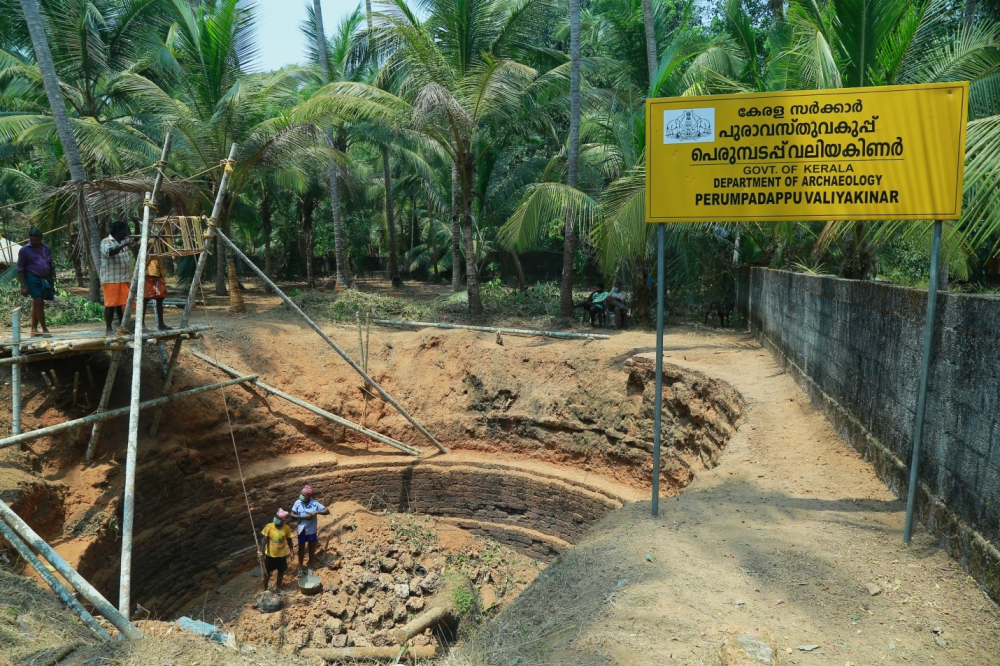
The Grandhavari has suggestions regarding the partition, which gave the temple of Perinthri (Perinthrikovil) to the members of the Perumpadappu Swarūpam. But the deity of Perinthrikovil (Fig. 3) is not considered as the family deity of the royal family of Kochi. It is surprising, as the convention for the family was to accept the local deity as their Paradevatha, as already mentioned. But this could be owing to the fact that there was another temple very close by, called Koippalli Kāvu (Fig. 4), whose deity, Koippalli Thevar, is considered as one of the family deities of the royal family. Both these temples have their sreekovil (sanctum sanctorum) dedicated to both Siva and Vishnu. Even today these temples are ministered by the Cochin Devaswom Board [6] which points towards their connection to the Kochi kingdom.
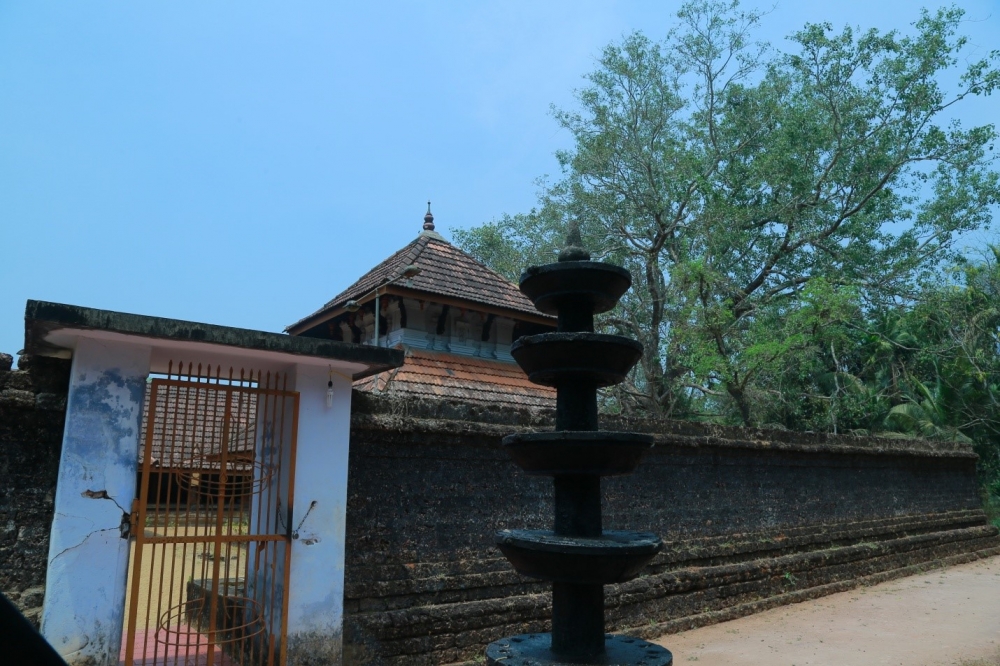
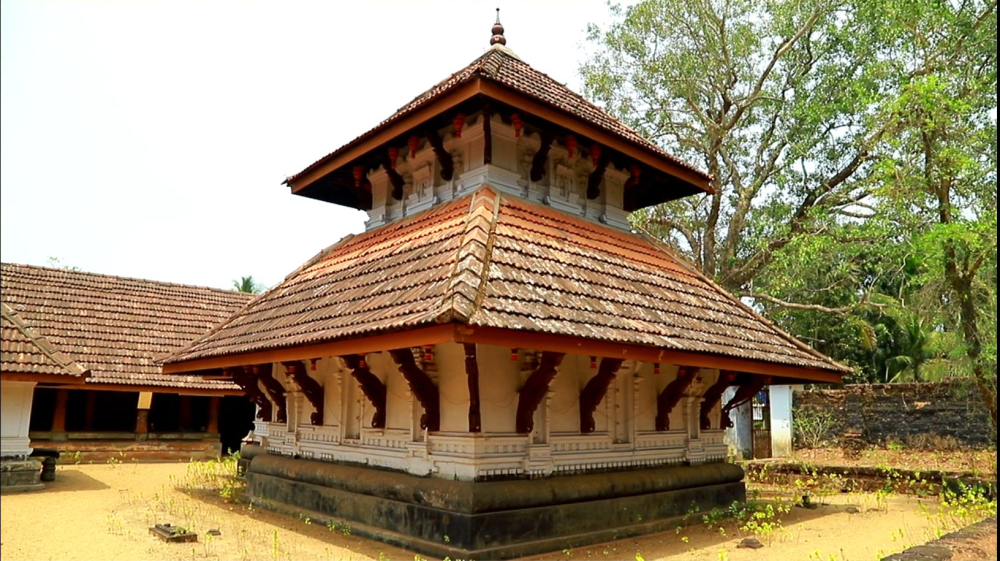
It is believed that the family left the Vanneri region and fled southwards owing to the harassment suffered at the hands of the invasive forces of Zamorin of Calicut around the thirteenth century. After fleeing, the royal family were supposed to have settled near Pazhayannur (northern extremities of modern Cochin state). Legends say that the deity of Pazhayannur (Fig. 5) became the paradevatha (family deity) of the royal family. It is unclear as to when they started residing there. Some local sources mark this period from the late thirteenth century to the fifteenth century.
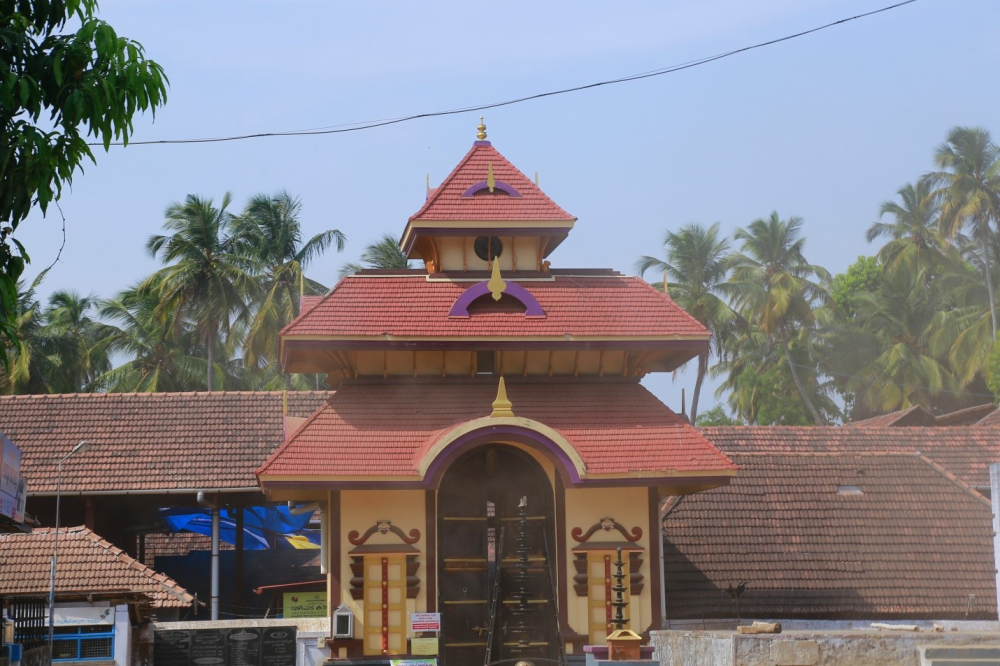
An interesting myth situates the goddess of the Pazhayannur temple in the history of the Cochin kingdom. According to this legend, the Pazhayannur Bhagavathy came from Varanasi, along with a king from Kochi who visited the holy land in the form of a rooster. The idol of the goddess in the present temple is laid in a corner of the original temple that belonged to Krishna; this brings up another legend that denotes the later consecration of the goddess. Today, one can see several roosters roaming freely inside the temple premises where the devotees feeding them with rice.(Fig. 6) This is in memory of the legend.
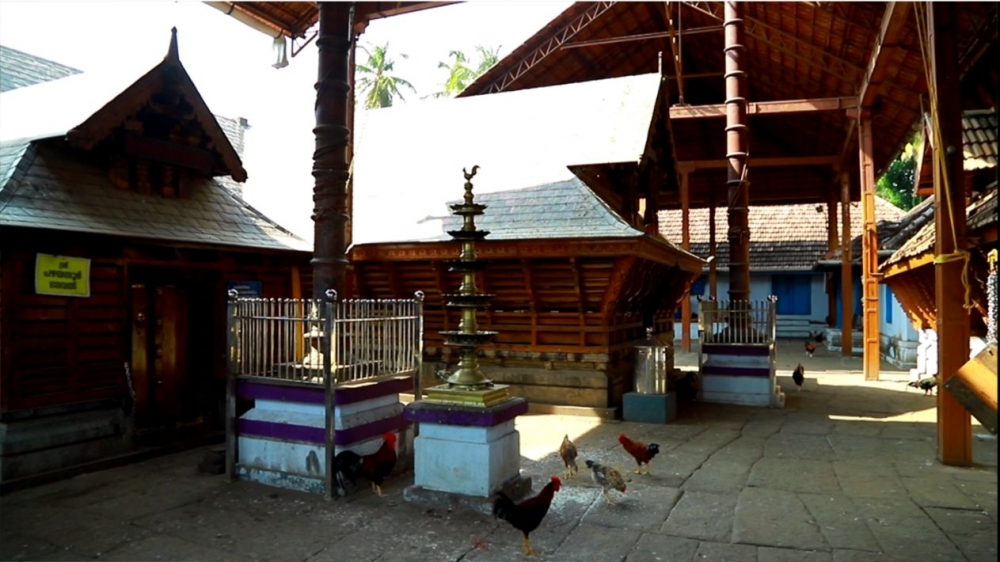
There were numerous attacks from the Zamorin which led to shifts in the location of the residence of the family, moving continually to the south, from Pazhayannur, to Thiruvilwamala and to Vellarappilly and Chazhur.
Rama Varma, another ruler of Cochin, is mentioned in Siva Vilasam. Medieval texts like Sukasandesam and Unniati Charitam allude to the unique position held by the ruler of Kochi among the Naduvazhis of Kerala. The Brahmins recognised them as Kshatriyas, an honour granted not even to the Zamorins. The Perumpadappu Mooppil (chief) exercised jurisdiction over a large number of temples in Kerala.
The Perumpadappu Swarūpam (Cochin royal family) had a few inscriptions of historical value. The Syrian copper plate (Veeraraghava Pattayam) of 1225 CE, issued by Veeraraghava, a ruler of the Perumpadappu royal house, is the most important one. It confers on the Christians of Kodungallur a number of privileges and rights. The Christian merchant Iravi Kortanan was conferred the tittle ‘Loka Perumchetti’ (great trader) and also the over-lordship of Manigramam. The Paliyam copper plate records the agreement between the Cochin Raja and the Dutch East India Company. The Jewish copper plate record of Bhaskara Ravivarma (1000 CE) from the Jewish synagogue at Mattancherry and the Chendamangalam record in Hebrew dated 1265 CE are the most important in this category.
In course of time several swarūpams developed and they brought into being new nadus. As a result of many marital alliances the Namboothiri rulers of Edappally handed over some regions to Perumpadappu Swarūpam and the latter came to be known as the rulers of Kochi. After it became the vassalage of the Zamorin, they helped the Portuguese to settle in Kochi and King Unni Goda Varma Tirumulpadu extended support in their efforts against the Zamorin based on a treaty between the Kingdom of Cochin and the Portuguese in 1500. Hence, the kingdom was protected by the Portuguese initially and similar treaties were initiated with the Dutch and English East India Companies later.
The development of the Kingdom of Cochin was influenced by two major factors. First, the increasing power of the Nediyiruppu Swarūpam in Calicut which challenged the autonomy of the kings of Cochin and secondly the increasing demand of pepper in the Indian Ocean trade. Calicut established a stronger political authority in the Malabar Coast from the thirteenth century onward which resulted in the deprivation of several rights of the king of Cochin. For example, the early modern Portuguese envoy Tomé Pires has noted that until the mid-sixteenth century, the palaces of Cochin were not supposed to use tiles as it was the sole privilege of the Zamorins. Likewise, the minting of coins was also exclusively kept for the Zamorin.[7] The king of Cochin was supposed to pay tribute to the Zamorin as a symbol of the acceptance of his authority.
On the other hand, this period also saw several important changes in this place. Pepper became an important commodity in the Indian Ocean trade networks from the thirteenth century onward. The Malabar Coast, especially Cochin and Calicut, benefitted from this sudden rise in demand for pepper as they both cultivated pepper in high quantities. As early as the fourteenth century, travellers like Ibn Battuta and Ma Huan had marked Cochin as an important port city and market.[8]
Relationship between the Portuguese and Cochin
When the second phase begins, the Portuguese traders had already reached the shores of Calicut and the commercial interests of different communities were competing with each other for maximum profit. The Portuguese came and settled in Cochin after being expelled from Calicut owing to their differences with the Zamorin over the presence of large Arab trade communities and their influence in Calicut. Carefully understanding the scenario of Malabar politics, the Zamorin’s power and authority, and his adversaries like the kingdom of Cochin, the Portuguese sailed back to Lisbon. As the profits gained from this expedition were exponentially higher for the Portuguese, the king decided to send another expedition to the Malabar Coast. A military commander and navigator named Pedro Alvarez Cabral led this voyage and he was successful in establishing a long-term friendship with Cochin that lasted for a century and half.
After Cabral’s disillusionment with the trade prospects between the Portuguese and the Zamorin, primarily owing to his other long-established trading links with the Arabs, the rendezvous ended with assault, arson and associated violence. The Portuguese left Calicut for Cochin upon realising the animosity existing between the Zamorin and the kingdom of Cochin.[9]
Cabral arrived on the shores of Cochin on December 24, 1500 and entered into a treaty for spices in exchange for money or merchandise with King Unni Goda Varma Tirumulpad. The king permitted the Portuguese to establish a factory, which was the first of its kind built there.
There are a few widespread rumours about this period, including that Cabral left for Lisbon with some Nair hostages from Cochin, leaving a few Portuguese back there. One Nair hostage named Idikkala Menon was sent back home after a considerable time. He became well-versed in the Portuguese language and later became a language interpreter. Similarly, the Portuguese hostages were taken care of by the King of Cochin. Such stories and myths handed down through generations of local people make these historical events more remarkable and the experience of this history more participatory from the local standpoint.
Meanwhile a second expedition was sent from Lisbon to Calicut led by Vasco da Gama. When the Portuguese demands to expel the Arab merchants from the coasts of Malabar were ignored by the Zamorin, they bombarded the city and destroyed the large Arab fleet. The Portuguese, led by Vasco da Gama, left Calicut and went to the king of Kochi with rich presents including a gold crown and a silver chair with cushions etc.
This was followed by a series of battles between the Zamorin and his Arab merchants against the Portuguese and their ally, the Kingdom of Cochin. With the support of a few Portuguese soldiers and their advanced ammunition, they not only withstood the Zamorin’s assault but succeeded in resisting him. It is interesting to note that during this period the residence of the Cochin royal family was in Mattancherry, the coastal area of Kochi, even though they had palaces and families residing in Vellarappilly and Chazhur.
The Kingdom of Cochin underwent several changes in this period, both politically and economically. The Portuguese established one of their political and commercial headquarters in Cochin in the 1530s which continued until 1663.[10] Cochin became the first Asian port city to establish direct contact with Atlantic ports. Under the control of the Portuguese, pepper production also underwent an important change. For example, we see the first systematic pepper gardens in Asia developing in Cochin in the first half of the sixteenth century.[11] Politically, the King of Cochin started to surpass the ritual restrictions like paying yearly tribute to the Zamorin.
However, this was happening at the cost of free trade and free markets in Cochin. While the Portuguese were attempting a monopoly in the pepper trade in Cochin with military force, many merchants left the port in search of a free market. For example, in the 1520s the indigenous Muslim merchant group, the Marakkar group, moved from Cochin to Calicut as a result of their clashes with the Portuguese. By the third decade of the sixteenth century, the Portuguese had established considerable control over the production and sale of pepper in Cochin.
Attacks occurred many times during the sixteenth and seventeenth centuries and every time the Portuguese supported the Kingdom of Cochin. The palace they built in Mattancherry in 1555 was gifted to the king of Cochin. Later, when the Dutch extended and reconstructed it in 1663, it began to be popularly called as the Dutch Palace of Kochi. A temple was also built inside the premises of the Dutch Palace, dedicated to Pazhayannur Bhagavathy, the family deity of the royal family.
The Dutch Period in the History of Cochin
It is believed that there were two branches of the royal family residing in Vellarappilly: one was called Vadakke (north) Kovilakam and the other Thekke (south) Kovilakam. It is generally thought that Vadakke kovilakam was the older branch of the family and Thekke kovilakam was a later branch. There were feuds between the two branches, typical of large families of this period, owing to reasons pertaining to the stronger influence the former had on the king. This was also the period of a number of adoptions within the family owing to the lack of female progeny in the lineage. There are mentions in the Dutch archives about some of the ceremonies and rituals associated with adoption of heirs. According to the local lore, the last such adoption took place in the sixteenth century in Vellarappilly.
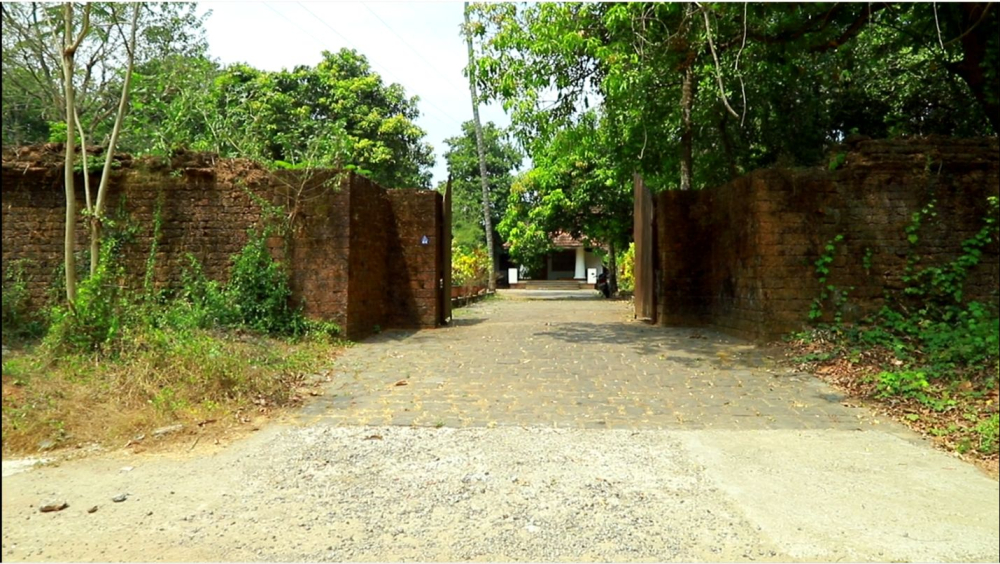
The Dutch traders entered the scene as early as 1604, when the Zamorin entered into a treaty with them. By the second half of the seventeenth century, the Cochin kings had also made connections with the Dutch traders, and then located in Colombo. It is popularly believed that a prominent person in the Cochin royal court, landlord Paliath Achan, had recommended that the king get into an agreement with the Dutch and the then king and Achan visited Colombo for this purpose.
In 1663, the Dutch attacked the Portuguese settlement in Cochin with the help of the Zamorin and defeated them. From that period onward, the Dutch East India Company established their commercial capital in the western coast in Cochin. The most important political issue faced in this period was the clashes between different royal lineages for the throne. Unlike the other swarūpams, the Perumpadappu Swarūpam of Cochin did not have a solid law for the succession. As a result, we see an increasing fight between several royal lineages in Cochin in order to achieve kingship. This created frequent internal rebellions in Cochin throughout the seventeenth century.
The Dutch East India Company became active in the local political scene of Cochin. For example, the Dutch supported the moothathavazhi (the elder lineage) to succeed with the help of the Zamorin in 1691.[12] At the same time, the Dutch also attempted to monopolise pepper production and trade from Cochin following the path of the Portuguese. To ensure the collection of pepper procurement from the hinterlands of Cochin, it was important for them to have an internal peace within the kingdom. Even after investing both politically and economically in Cochin, the Dutch attempts to monopolise the pepper trade were not successful.[13]
It is believed that sometime in the mid-eighteenth century (around 1755), a boy from the Vellarappally thekke kovilakam (southern branch), on the death of his mother, approached the king for help along with his mother’s younger sister and two of her sons and the king allowed them to reside in Thrippunithura, close to his palace. This boy later became the most well-known king of Cochin, namely the Sakthan Thampuran (literally, the powerful king) and consolidated the position and power of the state. Most stories about Sakthan Thampuran are popularised like myths and some of them offer insights into the political, social and familial scenarios of the period.
Rama Varma IX (1755–1805), known as Sakthan Thampuran, became the king after the death of his uncle, Rama Varma VIII, who was not efficient as a ruler which led to the strengthening of feudal lords like Paliath Achan who were closely associated with Dutch traders. After the consolidation of the territory of the kingdom, Sakthan Thampuran apparently started and maintained rigid law and order that eventually affected the traditional power of feudal lords. On the other hand, his policies attracted a large number of traders and merchants to the state and the kingdom flourished.
Another achievement of Sakthan Thampuran is related to the establishment of the city of Thrissur. The city planned around the temple of Vadakkumnathan and the large park called Thekkinkadu Maidanam and the well-connected road system in the city are attributed to him. Thrissur became the economic, cultural and trade centre of the kingdom of Cochin under him. It is believed that he began the well-known festival of Thrissur pooram.
After the death of Sakthan Thampuran in 1805, his maternal aunt’s son Rama Varma X (1805–1809), who was later known as Vellarappalliyil Theeppetta Thampuran, became the king. By this time all the four Thazvazhi (branches of the matrilineal royal family) had started to reside in Thrippunithura with each family having a quarter of the palace to reside in a traditional naalukettu way (Fig. 9). From 1790 onwards, Thrippunithura became the capital of Cochin royal state and the development of Thrippunithura and Poornathrayeesa temples started from that time. Sakthan Thampuran started the major renovations to the existing temple complex; he was an ardent devotee of Poornathrayeesa (Vishnu) and eventually all the members of the royal household accepted the servitude of the lord.
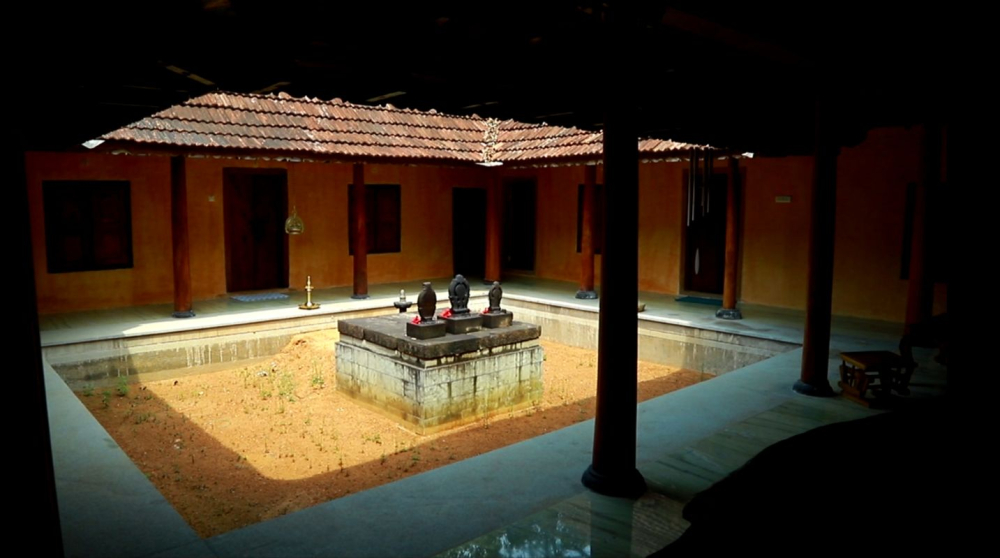
Like many other capital cities, Thrippunithura also had a wall separating the royal part of the city from the rest. Most of the palaces were inside of that fort and the temple marked the centre of the town. The structure of the town was similar to that of the structure of the city of Thiruvananthapuram that was the capital of Travancore. The influence is palpable and justifiable as the contemporary Travancore ruler, Karthika Thirunal Dharma Raja, was friends with Sakthan Thampuran.
British Protectorate in Cochin
Dutch control over the Kingdom of Cochin continued till the death of Sakthan Thampuran in 1805. After his death the kingdom came under the British Protectorate. This period has no direct connection with Thrippunithura and its development as Thrippunithura became the official residence of the king and the royal family.
The British Protectorate over Cochin was confirmed during the early nineteenth century. The British East India Company set Colin Macaulay up in Cochin as the Resident until 1810. During the reign of Veerakerala Varma, in 1809, Paliath Achan from Cochin clandestinely associated with the Travancore Dalava (equivalent to prime minister) Velu Thampi in planning and executing an insurrection. Militants from various Nair families of Cochin and Travancore attacked the Resident in Mattancherry. Macaulay escaped to Madras and later to England and many British servants were killed in the mutiny. Soon, Paliath Achan was captured and sent into forced exile to Bombay, ending the supremacy of the Paliath family in Cochin.
Fort Cochin was ceded to British and they established and strengthened their garrisons in Mattancherry and Thrippunithura. A court was also set up in Cochin for first time in 1812 and it remained functional until 1817.
It is popularly said that most of the successors of Sakthan Thampuran were not as powerful or strong-willed. The kings of Cochin from then worked with the Residents of the British East India Company and later the representatives of the British administration. The first Maharaja to be knighted by the British was Sir Rama Varma XIV (r. 1864–88, also known as Midhunamasathil Theeppetta Thampuran). Another popular king in the lineage was Sir Rama Varma XV, 1895–1914. He was also known as Rajarshi of Cochin and Abdicated Highness. The railways were first introduced during his reign; it is said that he sold an expensive gold thalekkettu (caparison) of the Poornathrayeesa temple to raise the money for extending the railway line from Shoranur to Kochi. The Panchayat Bill and Tenancy Act were passed during the same time. Many permanent reforms were brought into existence in revenue and accounts departments.
The next king, Ramavarma XVI (r. 1915–32), also known as Madirassiyil Theeppetta Thampuran, had to rebuild the Poornathrayeesa temple which was severely damaged in the ‘great fire’ of 1921. It is understood that the entire temple was destroyed except Anakkottil, Thattumalika, Oottupura and the western gopuram. Presently the western gopuram is the only structure that remains of the original construction from medieval times as the rest were rebuilt in the nineteenth century.
Rama Varma XVII (r. 1932–41), with the popular name Chovvarayil Theeppetta Thampuran, initiated the development of the Cochin harbour. He was succeeded by Kerala Varma (r. 1941–43) who introduced the food rationing system for the first time among the princely states. The next prominent king was Kerala Varma (r. 1945–47) whose name Aikya Keralam Thampuran suggests his role in the unification and formation of Kerala state joining the Malayalam-speaking regions of Malabar, Cochin and Travancore. Ramavarma Kunjunni Thampuran also known as Parikshit Thampuran (r. 1947–50) was the last King of Cochin upon the unification of Kerala and the elections for a democratic parliament.
Notes
[1] The Cheras were a line of rulers in southern India along with the Cholas and the Pandyas. The exact time or duration of the Chera rule is difficult to ascertain as most of the details are derived from the Sangam literature of the third century BCE and a few travel records. The Cheras of Karur-Vanchi whose rule can be dated as far back as c. third century BCE and the Kongu Cheras controlled central Tamil Nadu in the middle ages. The Chera Perumals of Makotai (modern Cranganore, Kerala), formerly known in literature as the Kulasekharas, were in power between The eighth and twelfth century CE. For more information on the Chera dynasty and the life of ancient Kerala, see M.G.S. Narayanan, Perumāḷs of Kerala: Brahmin Oligarchy and Ritual Monarchy: Political and Social Conditions of Kerala Under the Cēra Perumāḷs of Makōtai (c. AD 800 –AD 1124), (Kerala: Calicut University Press,1996).
[2] Mamankam is a festival related to trade fairs in ancient Kerala. It was conducted once every 12 years and lasted 28 days, during the time of Kulasekharas of the Chera dynasty from the fourteenth century till the eighteenth century. The venue of the festival was Thirunavaya, on the banks of the River Bharathapuzha in Malabar. The festival is remembered for the great trade fair associated with it as well as the bloody battles that occurred during the festival. At the end of the rule of Kulasekharas, the right of Mamankam passed to the kings of Perumpadappu and then to the Hindu Nair rulers of Valluvanad. Later the Zamorin of Kozhikode defeated the Valluvanad rulers in the Thirunavaya Wars (fourteenth century), resulting in a long-drawn rivalry and bloodshed between these two rulers. For more information, see N.M. Nampoothiri, Mamankam Rekhakal, (Calicut: Vallathol Vidya Peethom, 2005).
[3]Mailaparambil, Lords of the Sea, 29.
[4] Perumpadappu Granthavari states that “the last thavazhi (maternal lineage) of Perumpadappu swarūpam came into existence on the kaliyuga day Shodashangam surajyam”. Shodashangam surajyam is a cryptogram used to indicate the day when Cheraman Perumal partitioned his empire and distributed it among his own relatives.
[5] Logan. Malabar Manual, 256.
[6] The word devaswom means the property of god and in Kerala there are socio-religious trusts formed for the management of Hindu temples in the state with representatives from the communities and the government that are called devaswom boards. The property of each temple belongs to the deity and this trust is supposed to look after the property on behalf of the deity. There are five devaswoms under the ministry of devaswom boards namely Guruvayur, Travancore, Malabar, Cochin, and Koodalmanikyam; together they manage nearly 3000 temples.
[7] Tome Pires ((1465?–1524 or 1540) was a Portuguese apothecary who travelled to Southeast Asia and India after the Portuguese conquest of various lands. He documented and later wrote about the well-known spice trade that took place between Indian ocean coasts and Europe.
[8] Ibn Battuta (1306–1368/9) was a medieval Moroccan Muslim scholar and explorer who travelled across the world and his travelogues about various parts of India provide us significant insights into the socio-religious dynamics of those periods. One of these magnificent travelogues mention Calicut and its life in some detail. Ma Huan (1380–1460) was a Chinese traveller and translator who accompanied Admiral Zheng He on three of his seven expeditions to the Western Oceans. During the early 1400s he visited various parts of India including Cochin and Calicut. Upon his return to China, he wrote an extensive text based upon his notes on the geography, politics, weather conditions, environment, economy, local customs, even methods of punishment for criminals that he witnessed in these parts. Both the above-mentioned travellers and their writings are still considered significant in understanding the medieval societies that they visited.
[9] The tale is retold as follows: upon his arrival in Calicut, he saw lot of rival vessels belonging to Arabs or Moors. Even though he was warmly received by the Zamorin and obtained permission to set up a factory, the rival parties brought obstacles. His ships were prevented from obtaining the spices and his factory in Calicut was attacked and the second-in-charge Ayres Correa was killed. Cabral retaliated by seizing and destroying ten Arab ships laded with spices on board. He also bombarded the city of Calicut and destroyed coastal villages in revenge to the Zamorin being a mute spectator on the attack on his factory. Then he left for Cochin as he had heard from previous expeditions that Cochin was a strong rival to Calicut.
[10] Malekandathil, Portuguese Cochin and the Maritime Trade of India, 282.
[11] Pearson, Spices in the Indian Ocean World.
[12] s'Jacob, The Rajas of Cochin.
[13] Winius and Vink, The Merchant-Warrior Pacified.
Bibliography
Ayyar, K.V. Krishna. Zamorins of Calicut: From the Earliest Times down to A.D. 1806. Kozhikode: University of Calicut,1938.
Logan, William. Malabar Manual. Kozhikode: Mathrubhumi Books, 2014.
Malekandathil, Pius. Portuguese Cochin and the Maritime Trade of India, 1500–1663. Delhi: Manohar, 2001.
Mailaparambil, Binu John. Lords of the Sea: The Ali Rajas of Cannanore and the Political Economy of Malabar (1663–1723). Leiden: Brill, 2011.
Mathew, K.S. Cochin and Portuguese Trade with India in the 16th Century. New Delhi: Manohar, 1983.
Panikkasseri, Velayudhan. Sancharikal Kanda Keralam. Kottayam: Current Books, 2001.
Pearson, M.N. Spices in the Indian Ocean World. Farnham: Ashgate Publishing Limited, 1996.
s'Jacob, Hugo. The Rajas of Cochin, 1663–1720: Kings, Chiefs and the Dutch East India Company. New Delhi: Munshiram Manoharlal, 2000.
Variyar, M.R. Raghava. Sthanarohanam Catangukal. Edappal: Vallathol Vidya Peethom, 2005.
Winius, George Davison and Marcus P. M. Vink. The Merchant–Warrior Pacified: the VOC (the Dutch East India Company) and Its Changing Political Economy in India. New York: Oxford University Press, 1995.
